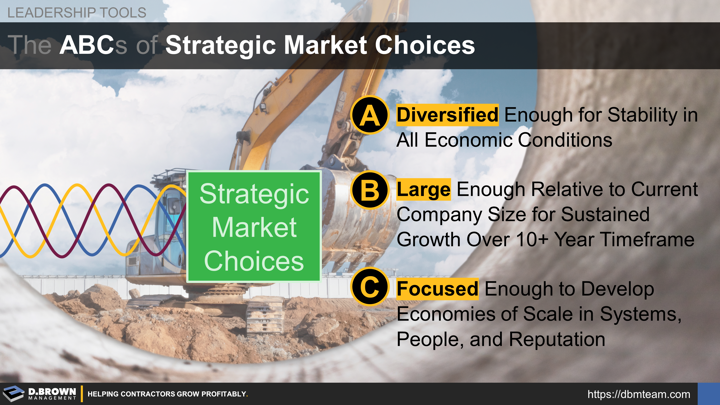There are multiple levels of strategic decisions that are required by a contractor. Decisions related to market strategy must balance out:
- Diversified enough for stability in all economic conditions. One example could be choosing a balance between several market sectors in a geography such as manufacturing work that drives need for housing, which in turn drives the need for public works infrastructure. Another example could be choosing a single market sector like housing and diversifying geographically to balance out cycles.
- Large enough relative to the current company size for sustained growth over a 10+ year timeframe. This is where strategies start to change as a contractor navigates different stages of growth. Ideally, the market itself will be growing at least as fast as you want to grow as a business, and you can continue to increase your share of that market. This allows you to make a lot of good decisions along the way including opportunity evaluation and selection.
- Focused enough to develop economies of scale in systems, people, and reputation. Where you start to see performance at 2-3X industry benchmarks is either in contractors that are in the early stages of growth (1-2), where decision rights are concentrated or those in the later stages (5-6+) that have figured out how to scale all aspects of the Contractor Business Model for functional area efficiencies while mastering the hand-off process for overall system effectiveness.
These choices must all be made on a strong strategic foundation focusing on what is unlikely to change over the next 10+ years.
A contractor will see these market decisions come to life starting with the customer and project opportunities they choose to pursue.
Learn more about making these strategic decisions:
- Strong Strategic Foundations - What Is Unlikely to Change?
- Markets (Benchmarks, Trends, Forecasts, and Predictions)
- Five Interlinked Questions to Define Your Strategy
- 6 Phases of the Strategy and Planning Process
- Levels of Strategic Decisions (The Basics)
- 4 Different Strategic Planning Objectives
- Headcount, Stages of Contractor Growth, and Growth Inflection Points
- Strategic Market Experiments

